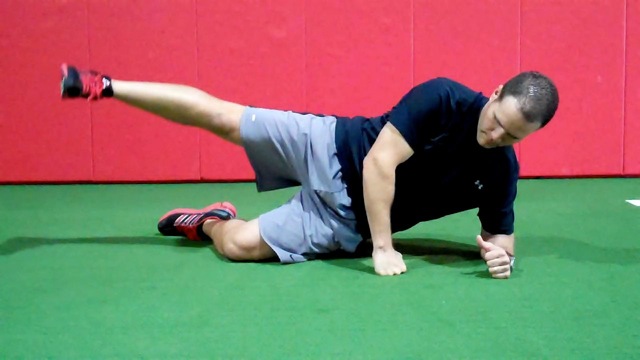It is no secret that improving hip strength and stability is an important part of any corrective exercise strategy as well as general training program. With limited time in training sessions, it is important to know what exercises bring about the highest muscle recruitment.
In original research published in the International Journal of Sports Physical Therapy (September 2011) researchers looked at various rehab exercises and activation of the gluteus medius and maximus muscles. Surface EMG was used in the study. In today's column I will address the top exercise for gluteus medius activation - the side plank with hip abduction.
Note: The percentages of MVIC (maximal voluntary muscle contraction) recorded were 103.11% for dominant leg down and 88.82% for dominant leg up. The dominant leg was determined by which leg a subject would use to kick a ball.
Execution
Position the body in a traditional side plank set-up with the supporting elbow beneath the shoulder and the legs aligned together (one on top of another). While maintaining a side plank, lift the leg up and down while keeping a neutral alignment between the shoulders, spine, hips, knees and ankles.
Execution
Position the body in a traditional side plank set-up with the supporting elbow beneath the shoulder and the legs aligned together (one on top of another). While maintaining a side plank, lift the leg up and down while keeping a neutral alignment between the shoulders, spine, hips, knees and ankles.
In the study, the researches used a cadence of 1/0/1 for the dominant leg up and a cadence of 2/0/2 for the dominant leg down. I am not sure why the change, but moving slowly under control is preferable. The critical point is maintaining a solid side plank with proper alignment while executing controlled abduction lifts. It should also be noted subjects were allowed to place the hand on the non-supporting arm on the floor for support during the testing.
 |  |
Application
This exercise is designed to strengthen the gluteus medius. Improving hip abductor strength will reduce valgus collapse at the knee and improve frontal plane hip stability. This is critical for runners and athletes at risk for ACL injuries. Engaging the gluteus medius properly will also help prevent IT Band issues and anterior knee pain.
Not every client will be able to perform the exercise the way it was alluded to in the article. To modify the activity, you can bend the bottom leg to 45 degrees and use hand support as needed prior to moving to the straight leg version (see photo on right).
Reference
Boren K, Conrey C, Le Coguic J, et al. Electromyographic Analysis of Gluteus Medius and Gluteus Maximus During Rehabilitation Exercises. International J Sports Phys Ther. 2011; 6: 206-223.
Brian Schiff, PT, CSCS, is a licensed physical therapist, respected author and fitness professional. Currently, he serves as the supervisor at the Athletic Performance Center in Raleigh, NC. Brian presents nationally at several professional conferences and seminars on injury prevention, rehab and sport-specific training. For more cutting edge training information, subscribe to his monthly Training & Sports Medicine Update at www.BrianSchiff.com.
















